Accounting and Finance Solutions: Cherry Hill Sports Analysis
VerifiedAdded on 2022/10/14
|6
|1340
|316
Homework Assignment
AI Summary
This document presents a comprehensive set of accounting solutions addressing a range of financial concepts and problems. It begins by defining and explaining the significance of EBITDA, detailing its role in assessing a company's operating performance. The solution then clarifies the balance sheet equation and its implications, followed by a comparison of gross profit and contribution margin, highlighting their differences. Further, the document contrasts franchising and licensing under intellectual property and analyzes the impact of depreciation methods on net income. The assignment also explores inventory methods, focusing on the alignment of FIFO with real-life operations. It then outlines the components of original equipment cost and explains the concept of relevant range and its effect on fixed costs. The break-even point and its implications are discussed, along with the disadvantages of the payback period method. Finally, the document provides a detailed solution to a case study involving Cherry Hill Sports Company, including calculations for break-even points, contribution margin, and financial analysis, with recommendations based on quantitative and qualitative factors, and references used.
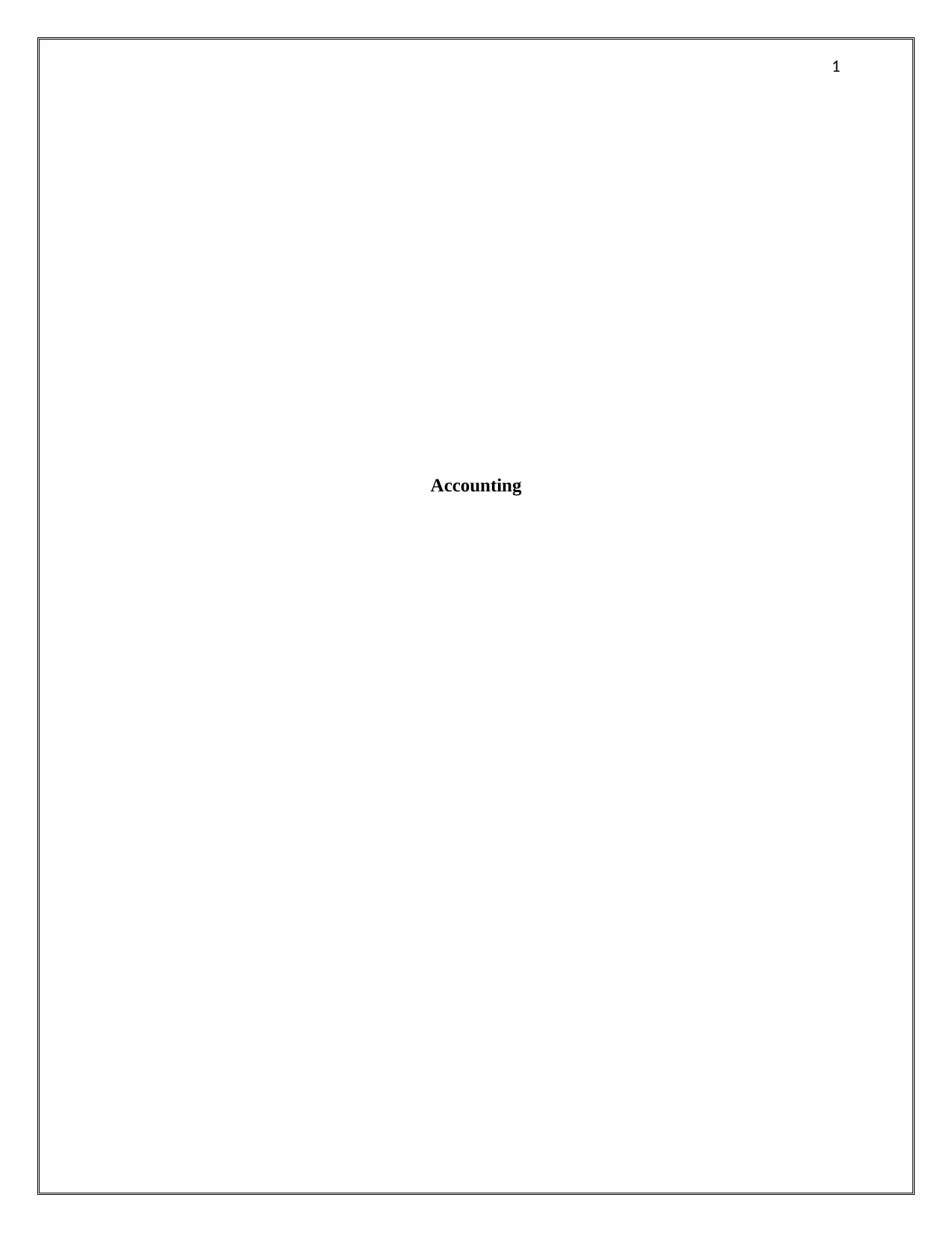
1
Accounting
Accounting
Paraphrase This Document
Need a fresh take? Get an instant paraphrase of this document with our AI Paraphraser
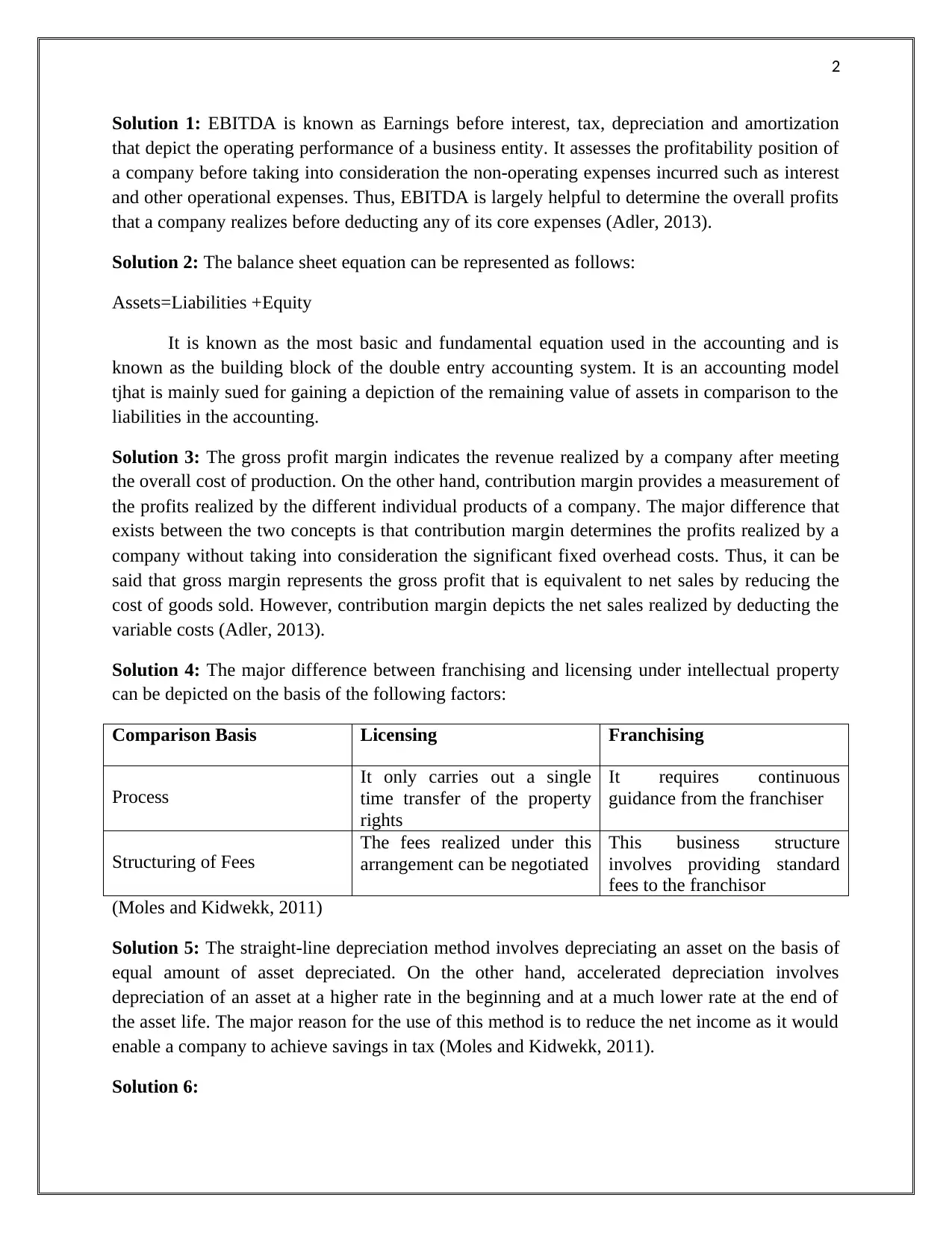
2
Solution 1: EBITDA is known as Earnings before interest, tax, depreciation and amortization
that depict the operating performance of a business entity. It assesses the profitability position of
a company before taking into consideration the non-operating expenses incurred such as interest
and other operational expenses. Thus, EBITDA is largely helpful to determine the overall profits
that a company realizes before deducting any of its core expenses (Adler, 2013).
Solution 2: The balance sheet equation can be represented as follows:
Assets=Liabilities +Equity
It is known as the most basic and fundamental equation used in the accounting and is
known as the building block of the double entry accounting system. It is an accounting model
tjhat is mainly sued for gaining a depiction of the remaining value of assets in comparison to the
liabilities in the accounting.
Solution 3: The gross profit margin indicates the revenue realized by a company after meeting
the overall cost of production. On the other hand, contribution margin provides a measurement of
the profits realized by the different individual products of a company. The major difference that
exists between the two concepts is that contribution margin determines the profits realized by a
company without taking into consideration the significant fixed overhead costs. Thus, it can be
said that gross margin represents the gross profit that is equivalent to net sales by reducing the
cost of goods sold. However, contribution margin depicts the net sales realized by deducting the
variable costs (Adler, 2013).
Solution 4: The major difference between franchising and licensing under intellectual property
can be depicted on the basis of the following factors:
Comparison Basis Licensing Franchising
Process
It only carries out a single
time transfer of the property
rights
It requires continuous
guidance from the franchiser
Structuring of Fees
The fees realized under this
arrangement can be negotiated
This business structure
involves providing standard
fees to the franchisor
(Moles and Kidwekk, 2011)
Solution 5: The straight-line depreciation method involves depreciating an asset on the basis of
equal amount of asset depreciated. On the other hand, accelerated depreciation involves
depreciation of an asset at a higher rate in the beginning and at a much lower rate at the end of
the asset life. The major reason for the use of this method is to reduce the net income as it would
enable a company to achieve savings in tax (Moles and Kidwekk, 2011).
Solution 6:
Solution 1: EBITDA is known as Earnings before interest, tax, depreciation and amortization
that depict the operating performance of a business entity. It assesses the profitability position of
a company before taking into consideration the non-operating expenses incurred such as interest
and other operational expenses. Thus, EBITDA is largely helpful to determine the overall profits
that a company realizes before deducting any of its core expenses (Adler, 2013).
Solution 2: The balance sheet equation can be represented as follows:
Assets=Liabilities +Equity
It is known as the most basic and fundamental equation used in the accounting and is
known as the building block of the double entry accounting system. It is an accounting model
tjhat is mainly sued for gaining a depiction of the remaining value of assets in comparison to the
liabilities in the accounting.
Solution 3: The gross profit margin indicates the revenue realized by a company after meeting
the overall cost of production. On the other hand, contribution margin provides a measurement of
the profits realized by the different individual products of a company. The major difference that
exists between the two concepts is that contribution margin determines the profits realized by a
company without taking into consideration the significant fixed overhead costs. Thus, it can be
said that gross margin represents the gross profit that is equivalent to net sales by reducing the
cost of goods sold. However, contribution margin depicts the net sales realized by deducting the
variable costs (Adler, 2013).
Solution 4: The major difference between franchising and licensing under intellectual property
can be depicted on the basis of the following factors:
Comparison Basis Licensing Franchising
Process
It only carries out a single
time transfer of the property
rights
It requires continuous
guidance from the franchiser
Structuring of Fees
The fees realized under this
arrangement can be negotiated
This business structure
involves providing standard
fees to the franchisor
(Moles and Kidwekk, 2011)
Solution 5: The straight-line depreciation method involves depreciating an asset on the basis of
equal amount of asset depreciated. On the other hand, accelerated depreciation involves
depreciation of an asset at a higher rate in the beginning and at a much lower rate at the end of
the asset life. The major reason for the use of this method is to reduce the net income as it would
enable a company to achieve savings in tax (Moles and Kidwekk, 2011).
Solution 6:
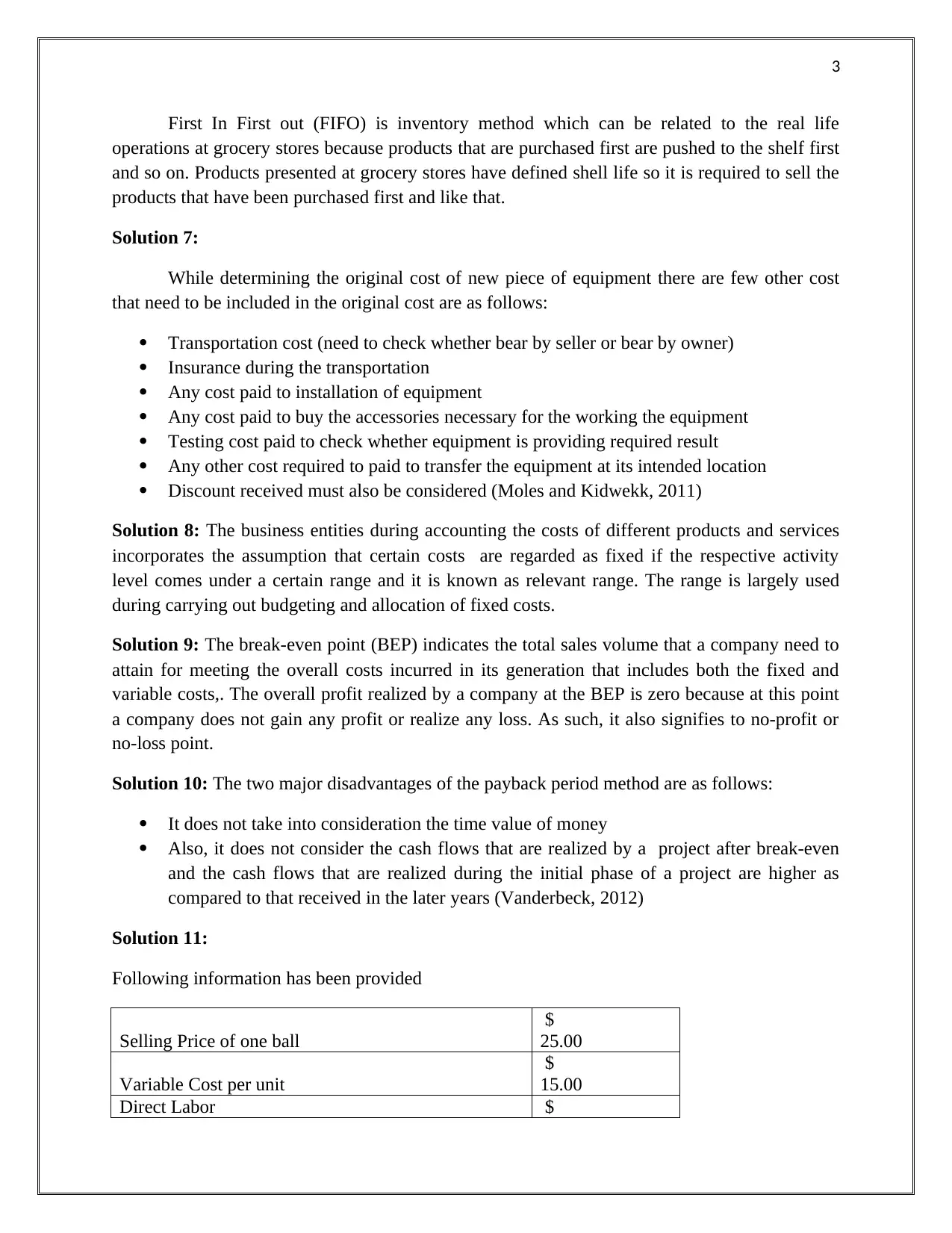
3
First In First out (FIFO) is inventory method which can be related to the real life
operations at grocery stores because products that are purchased first are pushed to the shelf first
and so on. Products presented at grocery stores have defined shell life so it is required to sell the
products that have been purchased first and like that.
Solution 7:
While determining the original cost of new piece of equipment there are few other cost
that need to be included in the original cost are as follows:
Transportation cost (need to check whether bear by seller or bear by owner)
Insurance during the transportation
Any cost paid to installation of equipment
Any cost paid to buy the accessories necessary for the working the equipment
Testing cost paid to check whether equipment is providing required result
Any other cost required to paid to transfer the equipment at its intended location
Discount received must also be considered (Moles and Kidwekk, 2011)
Solution 8: The business entities during accounting the costs of different products and services
incorporates the assumption that certain costs are regarded as fixed if the respective activity
level comes under a certain range and it is known as relevant range. The range is largely used
during carrying out budgeting and allocation of fixed costs.
Solution 9: The break-even point (BEP) indicates the total sales volume that a company need to
attain for meeting the overall costs incurred in its generation that includes both the fixed and
variable costs,. The overall profit realized by a company at the BEP is zero because at this point
a company does not gain any profit or realize any loss. As such, it also signifies to no-profit or
no-loss point.
Solution 10: The two major disadvantages of the payback period method are as follows:
It does not take into consideration the time value of money
Also, it does not consider the cash flows that are realized by a project after break-even
and the cash flows that are realized during the initial phase of a project are higher as
compared to that received in the later years (Vanderbeck, 2012)
Solution 11:
Following information has been provided
Selling Price of one ball
$
25.00
Variable Cost per unit
$
15.00
Direct Labor $
First In First out (FIFO) is inventory method which can be related to the real life
operations at grocery stores because products that are purchased first are pushed to the shelf first
and so on. Products presented at grocery stores have defined shell life so it is required to sell the
products that have been purchased first and like that.
Solution 7:
While determining the original cost of new piece of equipment there are few other cost
that need to be included in the original cost are as follows:
Transportation cost (need to check whether bear by seller or bear by owner)
Insurance during the transportation
Any cost paid to installation of equipment
Any cost paid to buy the accessories necessary for the working the equipment
Testing cost paid to check whether equipment is providing required result
Any other cost required to paid to transfer the equipment at its intended location
Discount received must also be considered (Moles and Kidwekk, 2011)
Solution 8: The business entities during accounting the costs of different products and services
incorporates the assumption that certain costs are regarded as fixed if the respective activity
level comes under a certain range and it is known as relevant range. The range is largely used
during carrying out budgeting and allocation of fixed costs.
Solution 9: The break-even point (BEP) indicates the total sales volume that a company need to
attain for meeting the overall costs incurred in its generation that includes both the fixed and
variable costs,. The overall profit realized by a company at the BEP is zero because at this point
a company does not gain any profit or realize any loss. As such, it also signifies to no-profit or
no-loss point.
Solution 10: The two major disadvantages of the payback period method are as follows:
It does not take into consideration the time value of money
Also, it does not consider the cash flows that are realized by a project after break-even
and the cash flows that are realized during the initial phase of a project are higher as
compared to that received in the later years (Vanderbeck, 2012)
Solution 11:
Following information has been provided
Selling Price of one ball
$
25.00
Variable Cost per unit
$
15.00
Direct Labor $
⊘ This is a preview!⊘
Do you want full access?
Subscribe today to unlock all pages.

Trusted by 1+ million students worldwide
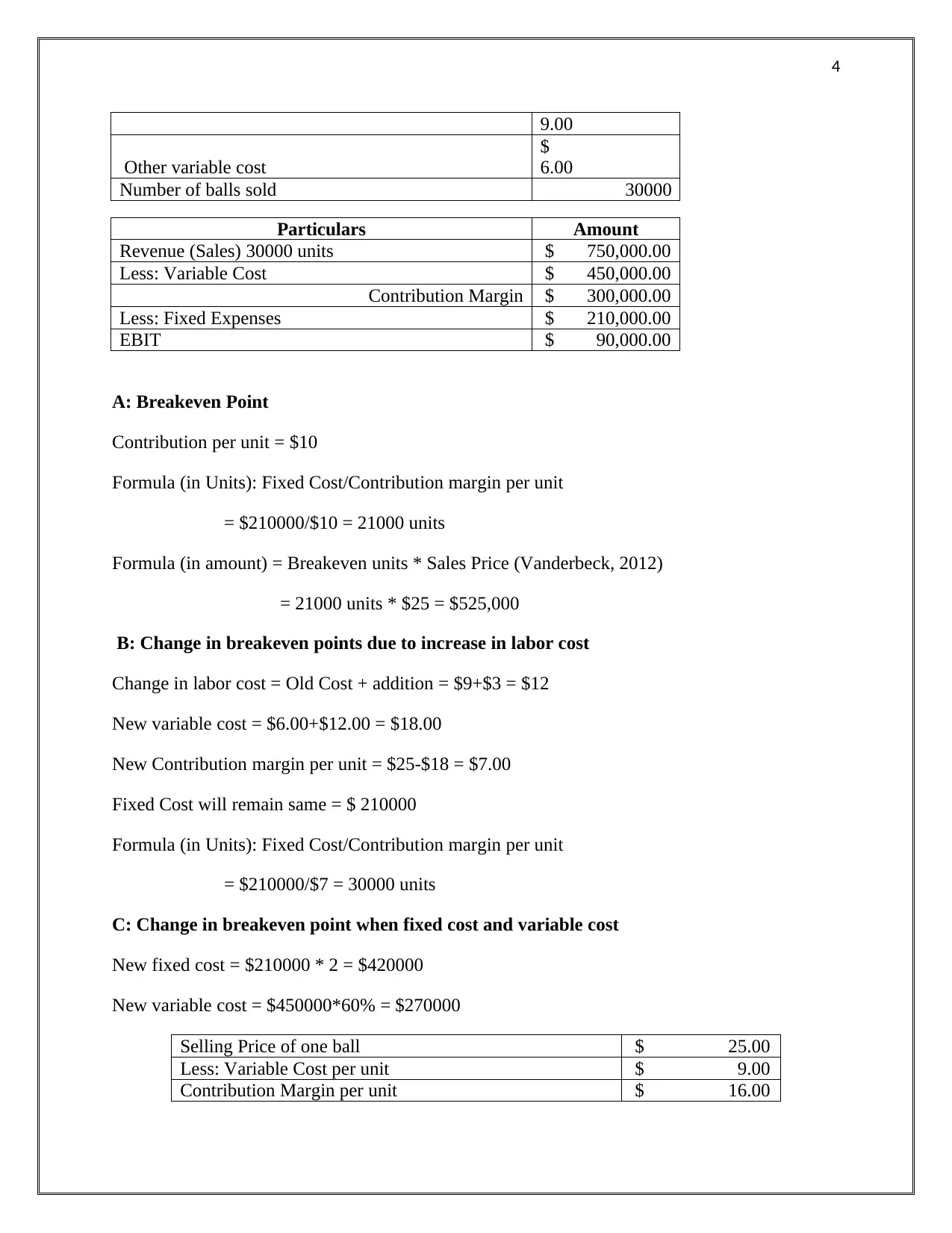
4
9.00
Other variable cost
$
6.00
Number of balls sold 30000
Particulars Amount
Revenue (Sales) 30000 units $ 750,000.00
Less: Variable Cost $ 450,000.00
Contribution Margin $ 300,000.00
Less: Fixed Expenses $ 210,000.00
EBIT $ 90,000.00
A: Breakeven Point
Contribution per unit = $10
Formula (in Units): Fixed Cost/Contribution margin per unit
= $210000/$10 = 21000 units
Formula (in amount) = Breakeven units * Sales Price (Vanderbeck, 2012)
= 21000 units * $25 = $525,000
B: Change in breakeven points due to increase in labor cost
Change in labor cost = Old Cost + addition = $9+$3 = $12
New variable cost = $6.00+$12.00 = $18.00
New Contribution margin per unit = $25-$18 = $7.00
Fixed Cost will remain same = $ 210000
Formula (in Units): Fixed Cost/Contribution margin per unit
= $210000/$7 = 30000 units
C: Change in breakeven point when fixed cost and variable cost
New fixed cost = $210000 * 2 = $420000
New variable cost = $450000*60% = $270000
Selling Price of one ball $ 25.00
Less: Variable Cost per unit $ 9.00
Contribution Margin per unit $ 16.00
9.00
Other variable cost
$
6.00
Number of balls sold 30000
Particulars Amount
Revenue (Sales) 30000 units $ 750,000.00
Less: Variable Cost $ 450,000.00
Contribution Margin $ 300,000.00
Less: Fixed Expenses $ 210,000.00
EBIT $ 90,000.00
A: Breakeven Point
Contribution per unit = $10
Formula (in Units): Fixed Cost/Contribution margin per unit
= $210000/$10 = 21000 units
Formula (in amount) = Breakeven units * Sales Price (Vanderbeck, 2012)
= 21000 units * $25 = $525,000
B: Change in breakeven points due to increase in labor cost
Change in labor cost = Old Cost + addition = $9+$3 = $12
New variable cost = $6.00+$12.00 = $18.00
New Contribution margin per unit = $25-$18 = $7.00
Fixed Cost will remain same = $ 210000
Formula (in Units): Fixed Cost/Contribution margin per unit
= $210000/$7 = 30000 units
C: Change in breakeven point when fixed cost and variable cost
New fixed cost = $210000 * 2 = $420000
New variable cost = $450000*60% = $270000
Selling Price of one ball $ 25.00
Less: Variable Cost per unit $ 9.00
Contribution Margin per unit $ 16.00
Paraphrase This Document
Need a fresh take? Get an instant paraphrase of this document with our AI Paraphraser

5
Particulars Amount
Revenue (Sales) 30000 units $ 750,000.00
Less: Variable Cost $ 270,000.00
Contribution Margin $ 480,000.00
Less: Fixed Expenses $ 420,000.00
EBIT $ 60,000.00
Formula (in Units): Fixed Cost/Contribution margin per unit
= $420000/$16= 26250 units
D: On the basis of quantitative analysis and factors it is highly recommended to select “C”
course of action as it has less breakeven units as compared to “B” course. The reason why this
course of action is selected is due to reason that it reduces the cost of variable cost by 40 % and it
helps in automation of manufacturing plant. Fixed cost got increased by 2 times but it can be
controlled in near future and it is highly expected that EBIT will increase more than the given
data.
E: On the basis of qualitative analysis it is also recommended to select “C” course of action as it
leads to less dependency on the labor and increase the volume in future due to automation of
manufacturing plant (McWatters and Zimmerman, 2015).
Particulars Amount
Revenue (Sales) 30000 units $ 750,000.00
Less: Variable Cost $ 270,000.00
Contribution Margin $ 480,000.00
Less: Fixed Expenses $ 420,000.00
EBIT $ 60,000.00
Formula (in Units): Fixed Cost/Contribution margin per unit
= $420000/$16= 26250 units
D: On the basis of quantitative analysis and factors it is highly recommended to select “C”
course of action as it has less breakeven units as compared to “B” course. The reason why this
course of action is selected is due to reason that it reduces the cost of variable cost by 40 % and it
helps in automation of manufacturing plant. Fixed cost got increased by 2 times but it can be
controlled in near future and it is highly expected that EBIT will increase more than the given
data.
E: On the basis of qualitative analysis it is also recommended to select “C” course of action as it
leads to less dependency on the labor and increase the volume in future due to automation of
manufacturing plant (McWatters and Zimmerman, 2015).
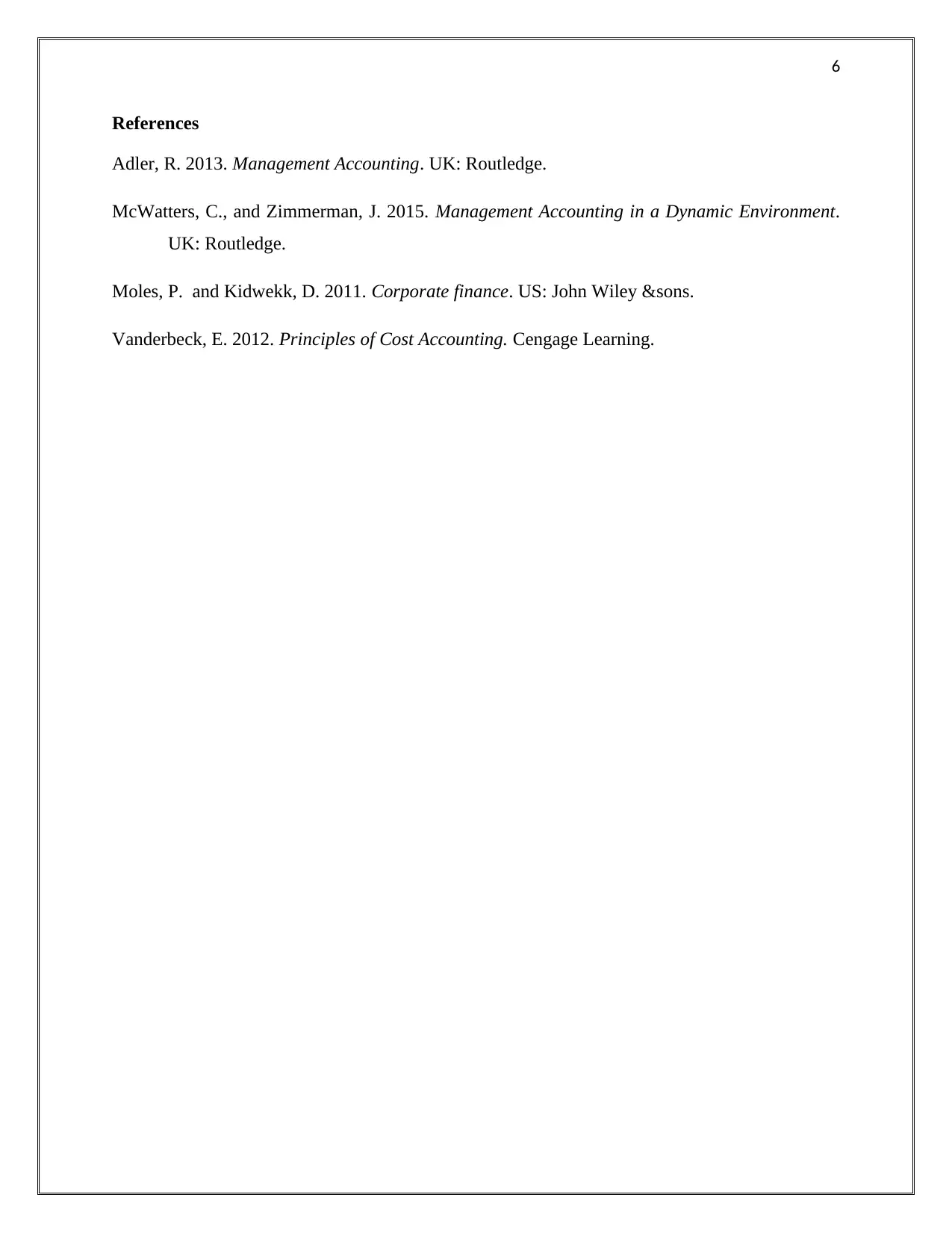
6
References
Adler, R. 2013. Management Accounting. UK: Routledge.
McWatters, C., and Zimmerman, J. 2015. Management Accounting in a Dynamic Environment.
UK: Routledge.
Moles, P. and Kidwekk, D. 2011. Corporate finance. US: John Wiley &sons.
Vanderbeck, E. 2012. Principles of Cost Accounting. Cengage Learning.
References
Adler, R. 2013. Management Accounting. UK: Routledge.
McWatters, C., and Zimmerman, J. 2015. Management Accounting in a Dynamic Environment.
UK: Routledge.
Moles, P. and Kidwekk, D. 2011. Corporate finance. US: John Wiley &sons.
Vanderbeck, E. 2012. Principles of Cost Accounting. Cengage Learning.
⊘ This is a preview!⊘
Do you want full access?
Subscribe today to unlock all pages.

Trusted by 1+ million students worldwide
1 out of 6
Related Documents
Your All-in-One AI-Powered Toolkit for Academic Success.
+13062052269
info@desklib.com
Available 24*7 on WhatsApp / Email
![[object Object]](/_next/static/media/star-bottom.7253800d.svg)
Unlock your academic potential
Copyright © 2020–2025 A2Z Services. All Rights Reserved. Developed and managed by ZUCOL.





